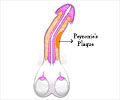Erectile dysfunction, thought as a curse many men suffer, is thankfully out of the closet. After the FDA approved drugs used to treat ED, many men are finding solutions to their problem.
Erectile dysfunction, thought as a curse many men suffer, is thankfully out of the closet. After the FDA approved drugs used to treat ED, many men are finding solutions to their problem.
“As more and more patients seek therapy for sexual dysfunction, it is increasingly important for clinicians in a wide range of specialties to become proficient in the mechanisms and systemic effects of these medications,” said Ernst R. Schwarz, M.D., Ph.D., a cardiologist at Cedars-Sinai Medical Center who specializes in therapies for men who suffer from erectile dysfunction (ED) and have heart problems, diabetes, high blood pressure or other related conditions.Schwarz and colleagues recently concluded a review of the medical literature, as well as their own research findings and clinical data, to determine what actually is known about the effects of long-term use of this class of drugs on various organ systems. Their findings appears in the June 8, 2006 issue of the International Journal of Impotence Research.
Studies so far suggest the drugs, called phosphodiesterase-5 inhibitors (PDE-5i), produce mostly beneficial results, and not just for erectile dysfunction. The FDA recently approved a reformulation of sildenafil for the treatment of primary pulmonary hypertension, a disease that tends to occur in young women, causing elevated blood pressures in the lung that can lead to heart failure and early death.
“When we look at all the different organ systems – the blood, the heart, the lungs, blood flow in the brain – there are hardly any negative side effects. In fact, just the opposite is true. There are beneficial effects for primary pulmonary hypertension, as well as for conditions such as heart failure and lack of oxygen in the heart,” said Schwarz. “The only issue is that the data we have are from relatively short-term studies. Viagra has been on the market since 1998 and the other two PDE-5 inhibitors were approved by the FDA in 2003. Therefore, we do not have multi-year follow-up studies. On the other hand, the drugs have been on the market for several years now and there have been no reports of negative long-term effects.”
While there are some differences among the three medications, they have many properties in common and work by limiting the activity of the enzyme phosphodiesterase-5, which is found in tissues and vessels of the penis, blood platelets, and smooth muscle of blood vessels. For the treatment of erectile dysfunction, the drugs’ constraint of the enzyme’s action results in increased levels of cyclic guanosine monophosphate (cGMP) and nitric oxide (NO), biochemicals that promote smooth muscle relaxation and increased blood flow in erectile tissue.
According to the article, PDE-5 inhibitors can be effective in treating erectile dysfunction even for many men who also have diabetes, those who are older, and those who have co-existing ischemic heart disease (reduced blood flow to the heart caused by plaque buildup in the arteries). Furthermore, say the authors, “since PDE-5 is found in smooth muscles of the systemic arteries and veins throughout the body, use of PDE-5i has been associated with various cardiovascular effects.”
“The original intention was to develop PDE-5 inhibitors as a treatment for angina, chest pain that occurs when the heart is starved for oxygen,” Schwarz said. “As such, their effects on the heart appear to be all beneficial. Nitrates and other substances commonly used to improve blood flow and oxygenation to the heart muscle have a side effect that we call the ‘steal phenomenon,’ in which blood is taken away from underperfused (flow-restricted) areas to improve blood flow in normal areas. In contrast, PDE-5 inhibitors actually improve blood flow even in areas where there is a blockage of an artery, thereby having a protective effect on the heart muscle.”
The drugs’ potential impact on visual function became a matter of controversy when a suspected link between PDE-5 inhibitors and vision loss led to lawsuits filed last year against the maker of Viagra. According to the article’s authors, however, “analysis of clinical trial data in more than 13,000 men and on more than 35,000 patient-years of observation” found occurrence of the visual disorder to be similar to that of the general population. “Even though individual cases have been reported for all PDE-5i, these recently published data do not suggest an increased incidence of NAION (non-arteric anterior ischemic optic neuropathy) in men who took PDE-5i for ED,” the article states.
(source:Eureka)











